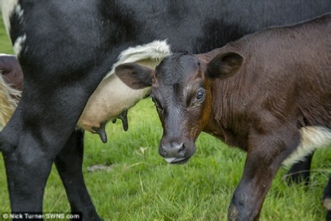
Cheese Making
A Little Piece of England
The government is committed to building 250,000 houses per year. This equates to an area the size of the Isle of Wight every 5.5 years about 38,000 Hectares. A city the size of Birmingham every 2.5 years. Much of this building will be on green fields used for food production.
In reflecting upon these scary facts perhaps it is time to think a little about our agricultural heritage. A very special treat for me over Christmas was to visit Standish Park farm, 300 acres of beautiful rolling hillside on the edge of the Beacon.
 This farm is very special as it is home to about 40 Old Gloucester cows and one bull. These magnificent animals make up almost 10% of the breeding females in the country. They are large cattle, coloured a rich dark brown in the cows, calves and steers, and almost black in the bulls. They have a white belly and a white stripe along the spine (finched back) continuing over the tail, and they normally have well-developed white horns with black tips. Originally they were kept because of their gentle temperament and as draught, milk and meat cattle. Unfortunately, they only produce about 30% of the milk of the modern milking cow which perhaps explains their decline.
This farm is very special as it is home to about 40 Old Gloucester cows and one bull. These magnificent animals make up almost 10% of the breeding females in the country. They are large cattle, coloured a rich dark brown in the cows, calves and steers, and almost black in the bulls. They have a white belly and a white stripe along the spine (finched back) continuing over the tail, and they normally have well-developed white horns with black tips. Originally they were kept because of their gentle temperament and as draught, milk and meat cattle. Unfortunately, they only produce about 30% of the milk of the modern milking cow which perhaps explains their decline.
Jonathan Crump who farms this land has shown huge enterprise converting their high protein and high butterfat milk into unpasteurised cheese, single and double Gloucester. Single Gloucester can only be produced in Gloucestershire and is a PD0 cheese (product designation of origin) and the farm must have at least one Gloucester cow. What is unique to Jonathan's cheeses is that they are produced exclusively from the only herd of Gloucester cows in Gloucestershire.
In 2014 the Daily Mail ran a story urging people to eat single Gloucester cheese to save this “very rare” breed. Over the Christmas period my extended family consumed 12 pounds of these quite exquisite cheeses. The single Gloucester matures at about 2 months, it is soft and very pale it has a wonderful firm taste with a hint of citrus after each mouthful. The double has the colour of a pale red Leicester it is a harder cheese, rich, creamy and has a rounded clean mellow and buttery flavour, matured for at least 4 or 5 months.
You do not have to eat this cheese to save the breed as once you have tried, you will want to eat more simply because it is quite delicious. My 1 ½ year-old granddaughter will vouch for that.
For those Francophiles out there the single Gloucester has a little in common with a young Cantal bought from a French market on warm sunny day. Jonathan clearly loves his cows and to see him wandering amongst the herd who happily follow him is a small part of a disappearing England that we must not lose.
These contented cows and Jonathan are producing something very special and for those who appreciate a taxing walk up a steep hill, what better way to spend 3 or 4 hours walking from our parish along the bridle path to Oxlynch lane and then a brisk walk up the lane, through the farm to the top of the Beacon. Armed, of course, with fresh crispy bread and a large chunk of Gloucester cheese. Look back down the hill at those spectacular gentle cattle and enjoy their truly delicious cheese. The view from the top is pretty good too!
Over the next few editions I would intend to highlight a few of our local farms who make such a contribution to food production, in or adjoining our Parish.
Daniel James








Eastington Community News Magazine. Community news for and by the people of Eastington, Gloucestershire
| Parish Council News |
| District council News |
| County Council News |
| Council links |
| Village Agent |
| Nbhd Warden |
| West of Stonehouse (WoS) |
| Ecotricity |
| Eastington Primary School |
| Playgroup |
| For the Little Ones |
| St Michaels Anglican Church |
| Eastington Methodist Church |
| ECLT (Land Trust) |
| EARS (Road Safety) |
| ECO (Orchard Group) |
| PROWD & Walking Group |
| Slimming World |
| Mr Beebee |
| Canal Update |
| Dog Bins |
| Pond Restoration |
| Weather |
| Cheese making |
| Defibrillators Installed |
| Phone Box |
| Severn Vale Rotary |
| Eastington Egg Hunt |
| Other Eastington Events |
| Activities nearby |